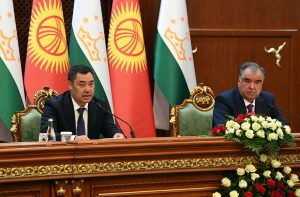On June 28-29, Kyrgyz President Sadyr Japarov traveled to the capital of Tajikistan, Dushanbe, to meet with Tajik President Emomali Rahmon. Coming several weeks after deadly clashes on the Kyrgyz-Tajik border, the meeting ended with a joint statement reiterating their mutual commitment to good neighborly relations but no breakthroughs.
The joint statement posted to the Kyrgyz president’s website included 25 points, most rehashing established diplomatic niceties such as “Kyrgyz-Tajik relations are based on centuries-old historical ties, common cultural and spiritual values” and stressing the need for both sides to “accelerate” negotiations on border delimitation and demarcation.
Around 40 percent of the roughly 984-kilometer Kyrgyz-Tajik border remains unresolved nearly 30 years after the dissolution of the Soviet Union made the boundary an international border. Kyrgyzstan and Tajikistan began negotiations on the border in 2002 and Rahmon remarked in his statement following the bilateral meeting that in that nearly 20-year period, there have been 180 meetings of the joint commission and various working groups.
Japarov, whose trip to Tajikistan had been scheduled for May before the April 28-29 clashes, referred to the events as a “heavy test” for the two countries. Rahmon called it a “tragic incident.”
Kyrgyz authorities reported 36 deaths and Tajik authorities reported 19 deaths after violence broke out near the Tajik exclave of Vorukh, reportedly over the installation of surveillance cameras at a water distribution station. In 2015, there were clashes in the same area over a blocked road and blocked canal. But what began, as in past incidents, with fist-fights and rock throwing escalated swiftly into gunfire, burning homes, and the involvement of border forces. Not only did the violence escalate at the initial site, but clashes quickly broke out across the border, with an RFE/RL map indicating clashes in at least 17 areas along the border.
Despite Japarov’s trip being rescheduled because of the border violence, the tangible results of the visit were almost as if the violence had never happened. As noted above, the 25-point joint statement included nothing truly new. Meanwhile, the documents signed by the two sides covered anodyne matters like cooperation on pensions and youth policy, between the respective civil services, and between the Kyrgyz and Tajik national news agencies.
Rahmon referred to a draft document in his statement in which another 32 kilometers of the border had been decided, but it has not been signed yet.
A return to the pre-April status quo is preferable to continued violence, but the distinct lack of actual progress on deciding the border leaves the door open for future clashes.
The Kyrgyz side invited Rahmon to make an official visit to Kyrgyzstan, though no dates have been announced yet.

































